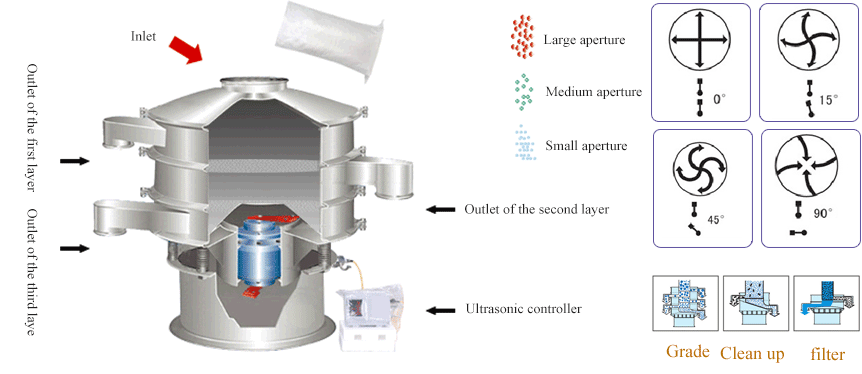Honey, often referred to as “liquid gold,” has been cherished for centuries for its rich taste, health benefits, and versatility. Yet, achieving the pure, smooth honey we see on store shelves is no simple task. Raw honey, as it exits the hive, contains impurities such as wax, pollen, and debris that need to be removed to ensure quality, safety, and consumer satisfaction. This is where impurity filtration sieving machines come into play. These advanced tools are pivotal for manufacturers in the food industry, enabling the production of high-quality honey that meets both industry standards and consumer expectations.
This blog explores the science behind impurity filtration sieving machines and their indispensable role in honey processing, highlighting how they contribute to efficiency, quality, and sustainability.
1. The Challenges of Processing Raw Honey
Impurities in Raw Honey
Raw honey is a natural product, harvested directly from the hive. While this purity is part of honey’s charm, it also introduces a range of potential impurities. These can include:
- Wax: Beeswax fragments are often present in freshly harvested honey, either from the honeycomb or as leftover particles from the bees’ processing. Wax can impact honey’s texture and appearance, making it unappealing to consumers.
- Pollen: While some consumers may seek out honey rich in pollen for its health benefits, too much pollen can affect the flavor profile and clarity of the honey.
- Dirt and Debris: Small foreign objects such as dirt, tiny insects, or even small bee parts can find their way into the honey during the extraction process.
The presence of these impurities makes filtration an essential step in ensuring that honey is not only safe but also attractive and appealing to the end consumer.

The Demand for Purity
The modern consumer demands honey that is free from contaminants and consistent in quality. Filtration helps eliminate impurities that could affect taste, texture, and appearance, ensuring the final product is perfectly smooth, clear, and free of unwanted particles. Additionally, the food industry is governed by strict regulations concerning purity and safety. These regulations require that manufacturers meet quality standards, which sieving machines are specifically designed to achieve.
Traditional Methods vs. Modern Challenges
While traditional methods such as manual straining or gravity filtration were once common, they cannot match the efficiency or precision of modern sieving machines. Manual methods often result in inconsistencies and fail to filter out fine particles, which are critical to achieve the desired honey quality. In contrast, sieving machines are automated, allowing for consistent results and faster processing times. These machines also prevent the human error inherent in manual methods, ensuring the honey remains pure and free from impurities.
2. The Role of Sieving Machines in Honey Filtration
Advanced Filtration Technology
Sieving machines have evolved significantly, incorporating technology that makes them far more efficient and precise than traditional filtration methods. These machines typically use a combination of mesh screens, vibrational movement, and sometimes even ultrasonic or air pressure technologies to filter honey effectively. Let’s break down the key elements that contribute to their success:
- Mesh Size: Mesh screens are the first line of defense in filtration. Different honey types and production scales require different mesh sizes. For example, finer mesh screens are used for removing microscopic debris or wax, ensuring honey’s smooth texture and clarity. The ability to adjust mesh size allows manufacturers to filter specific impurities based on the type of honey being processed.
- Vibration Technology: Many modern sieving machines incorporate vibration technology that gently shakes the honey across the mesh, ensuring that even the finest particles are captured. This prevents the clogs that can occur in traditional filters, ensuring a consistent flow of honey through the system.
- Air or Ultrasonic Technology: Some advanced systems even use ultrasonic waves or air pressure in conjunction with sieving, improving efficiency and ensuring that every impurity, no matter how small, is captured. This multi-layered filtration method ensures the purity of the honey while preserving its natural qualities.

Consistency and Quality
The ability to maintain a high standard of quality with every batch is paramount in any food production process. Sieving machines ensure that no matter how large or small the production volume, each batch of honey undergoes the same rigorous filtration process. This consistency is crucial for meeting regulatory standards and ensuring customer satisfaction. Moreover, honey manufacturers must maintain a high-quality product with every production cycle, as fluctuations in product quality can damage brand reputation.
Scalability for Industrial Production
Sieving machines are designed to scale, meaning they can be used for both small batches of premium honey and larger industrial volumes. As demand for honey continues to rise globally, manufacturers need machinery that can keep up with production without compromising the quality of the product. Filtration sieving machines allow manufacturers to filter large volumes of honey while maintaining the same high level of purity and texture.
3. The Broader Impact of Sieving Machines on Honey Production
Enhanced Consumer Trust
When consumers purchase honey, they expect it to be free from impurities such as wax, pollen clumps, or dirt. By investing in high-quality sieving machines, manufacturers ensure that the honey they produce is consistent, clean, and meets consumer expectations. A smooth, impurity-free product strengthens a brand’s reputation and encourages repeat purchases. The higher the product’s quality, the stronger the customer’s trust in the brand—something that is crucial in a highly competitive market.
Supporting Sustainability
Sustainability in food production is increasingly important to both consumers and manufacturers. Sieving machines support sustainability by ensuring that honey production is efficient and waste-free. For example, impurities like beeswax can be captured during the filtration process and reused in other products, such as cosmetics, candles, or food packaging. Furthermore, these machines improve efficiency, reducing energy and water consumption during the filtration process. By minimizing waste and increasing the yield of purified honey, sieving machines help manufacturers adopt more eco-friendly practices.

Driving Innovation in Honey-Based Products
The advancement of filtration technology has also led to innovation within the honey industry. Manufacturers can now explore new product lines, such as flavored or infused honey, while ensuring that all impurities are removed. For instance, honey used in cosmetics or skincare formulations must be of the highest purity to ensure effectiveness and safety. Sieving machines enable manufacturers to produce specialized products that cater to niche markets, providing opportunities for growth and differentiation.
Conclusion
Honey filtration is not merely a production step—it’s an art that combines nature’s finest gift with advanced technology to create a product that is both safe and beautiful. Impurity filtration sieving machines are at the heart of this process, ensuring that honey remains pure, consistent, and ready to meet the demands of both consumers and regulatory bodies.
By integrating state-of-the-art filtration technology, honey manufacturers can ensure that their products stand out for their quality, enhance consumer trust, and remain competitive in a fast-evolving market. As the industry continues to demand higher quality, sustainability, and innovation, impurity filtration sieving machines will remain an essential part of achieving honey perfection. With these machines, honey manufacturers can ensure that every jar is as pure and pristine as the hive it came from.
